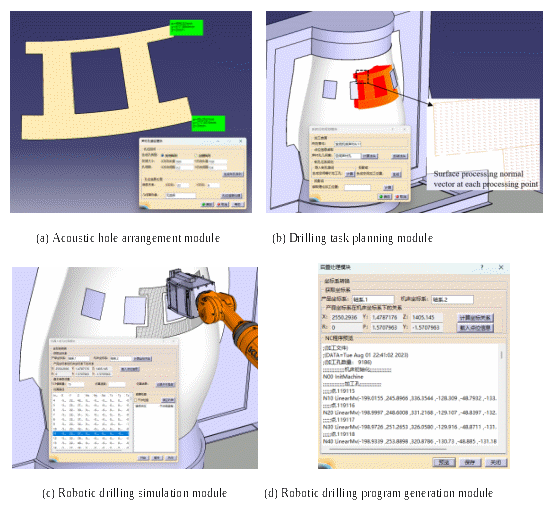Aero-engine noise is the primary noise source of a modern large aircraft. With the increasing bypass ratio of aero engines, fan noise replaces jet noise as the primary noise source of aero-engine. Laying acoustic liners in the nacelle is one of the most effective means to reduce aero-engine fan noise.
Aero-engine nacelle acoustic liners are complex curved surface subassemblies with tens of thousands of dense acoustic holes for noise reduction. Traditional robotic drilling systems with a single spindle and conventional teaching programming cannot meet the high-quality and high-efficiency drilling requirements for nacelle acoustic liners.
In a study published in the Robotics and Computer-Integrated Manufacturing, Dr. YANG Yongtai’s group from Fujian Institute of Research on the Structure of Matter of the Chinese Academy of Sciences designed a novel robotic multi-spindle drilling system and the drilling task planning and offline programming of the robotic drilling system for aero-engine nacelle acoustic liners.
The researchers designed and developed a robotic multi-spindle drilling system. Meanwhile, they demonstrated a scheme of acoustic hole arrangement on a nacelle acoustic liner CAD model. Then, they proposed the concept and definition of a virtual surrogate hole in robotic multi-spindle drilling. After that, the researchers provided a holistic task-planning strategy for multi-spindle drilling of the nacelle acoustic liner. In drilling task planning, a layout optimization model of virtual surrogate holes is established based on the minimum mutually exclusive set cover (MMESC) problem. Based on this, the generation and layout optimization methods of virtual surrogate holes based on intelligent optimization algorithms are developed.
The researchers also discussed drilling pose calculations of the multi-spindle end-effector for single-hole and multi-hole drilling scenes. In addition, they developed an intelligent optimization method for the robotic multi-spindle drilling path for virtual surrogate holes. Finally, the researchers designed and developed an offline programming (OLP) system for robotic multi-spindle drilling of nacelle acoustic liners based on the methods and algorithms above.
This study demonstrates a novel robotic multi-spindle drilling system for aero-engine nacelle acoustic liners and solves a series of problems, such as the automated arrangement of acoustic holes, the layout planning of virtual surrogate holes, the pose calculation of the multi-spindle end-effector, and the path planning of the robotic multi-spindle drilling.

The software interfaces of the main functional modules of the OLP system (Image by Dr. YANG’s group)
Contact:
Dr. MEI Biao
Fujian Institute of Research on the Structure of Matter
Chinese Academy of Sciences
Email: biaomeiac@fjirsm.ac.cn